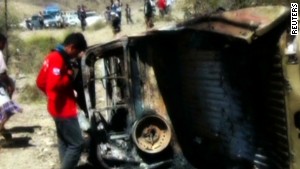Did Yemen, U.S. kill al Qaeda's chief bomb maker?
April 23, 2014 -- Updated 1209 GMT (2009 HKT)

U.S. aids Yemeni counterterror mission
VIDEO Please enlarge screen
At least 65 suspected
terrorists killed. Assaults from both the ground and the sky. And elite,
clandestine U.S. forces joining Yemeni commandos in targeting al Qaeda
in the Arabian Peninsula -- considered al Qaeda's most dangerous
affiliate.
But what would make the
raid in southern Yemen most significant is if it yielded a target that
Americans and Yemenis have been looking for: Ibrahim al-Asiri, the
group's chief bomb maker.
While U.S. officials said
the operation didn't directly target him, al-Asiri is among those
suspected to have been killed in the Sunday firefight, a high-level
Yemeni government official told CNN. But DNA test results are not due
for several days.
 Report: Al Qaeda bomb maker may be dead
Report: Al Qaeda bomb maker may be dead
 The impact of US drones in Yemen
The impact of US drones in Yemen
 Official: At least 65 militants killed
Official: At least 65 militants killed
.
Who is al-Asiri?
He's the alleged mastermind of al Qaeda's most creative and disturbing explosive devices.
Bomb plots he's accused of creating -- such as the 2009 underwear bomb plot and printer bombs dispatched to the United States in 2010 -- almost worked.
He even sacrificed his
younger brother, a suicide bomber, in a failed attempt to kill Saudi
Arabia's head of counterterrorism in 2009.
Al-Asiri constructed a
bomb like none al Qaeda had produced before: a device designed to be
inserted into the rectum of a suicide bomber containing around 100 grams
of PETN, a difficult-to-detect white powdery explosive.
In the end, only his younger brother was killed.
.
What led up to this raid?
A video and a threat.
A recently released video showed about 100 suspected al Qaeda members meeting at a training camp in Yemen.
In the middle of the
video, the man known as al Qaeda's crown prince, Nasir al-Wuhayshi,
appears brazenly out in the open, greeting followers in Yemen.
Al-Wuhayshi is the No. 2 leader of al Qaeda globally and the head of AQAP.
In a speech to the
group, al-Wuhayshi makes it clear that he's going after the United
States, saying: "We must eliminate the cross. ... The bearer of the
cross is America!"
Retired U.S. Gen. Richard Myers said the video raised serious concerns.
"If that's true, then
you have to go after them," Myers told CNN's "The Situation Room." "I
don't think that's sufficient in the end to defeat al Qaeda, but I think
it's important that we go after them in this case."
.
What role did the U.S. play?
A U.S. official who
spoke on the condition of anonymity said no Americans took part in
combat on the ground, but U.S. forces did wear night vision gear and
flew Yemeni forces to a remote, mountainous spot in southern Yemen.
The Yemeni helicopters
that the U.S. personnel flew were Russian-made, which helped to minimize
the U.S. footprint during the operation.
And CIA drones are suspected to have targeted al Qaeda fighters, weapons locations and a training camp.
Pentagon spokesman Adm.
John Kirby declined to detail the U.S. involvement in the latest
anti-terror operation, though he did highlight its partnership with
Yemen.
"We continue to work
with the Yemeni government and the Yemeni armed forces to help them
improve their counterterrorism capabilities inside the country," Kirby
said. "That work continues, and it will continue."
CNN's Paul Cruickshank, Nic Robertson, Tim Lister and Greg Botelho contributed to this report.

No comments:
Post a Comment